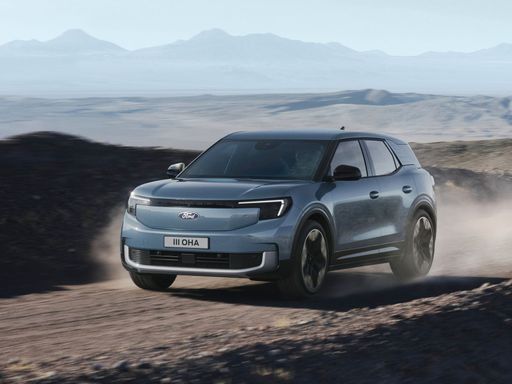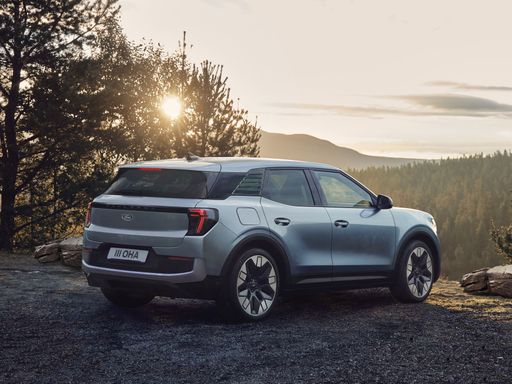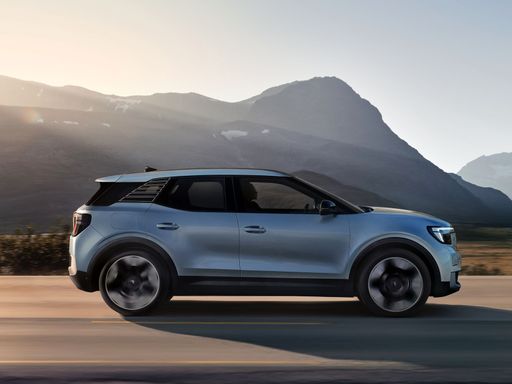Ford Explorer EV VS Nissan Primastar Transporter – Specs, Efficiency & Price Comparison
Which model is the better choice – the Ford Explorer EV or the Nissan Primastar Transporter? We compare performance (340 HP vs 170 HP), boot capacity (450 L vs ), efficiency (14.50 kWh vs 6.70 L), and of course, the price (34200 £ vs 35000 £).
Find out now which car fits your needs better!
The Ford Explorer EV (SUV) is powered by a Electric engine and comes with a Automatic transmission. In comparison, the Nissan Primastar Transporter (Cargo Van) features a Diesel engine and a Manuel or Automatic gearbox.
When it comes to boot capacity, the Ford Explorer EV offers 450 L, while the Nissan Primastar Transporter provides – depending on what matters most to you. If you’re looking for more power, you’ll need to decide whether the 340 HP of the Ford Explorer EV or the 170 HP of the Nissan Primastar Transporter suits your needs better.
There are also differences in efficiency: 14.50 kWh vs 6.70 L. In terms of price, the Ford Explorer EV starts at 34200 £, while the Nissan Primastar Transporter is available from 35000 £.
Compare all the key specs now and find out which model fits your lifestyle best!
Ford Explorer EV
The Ford Explorer EV marks a significant step forward in the brand's journey towards electrification, offering an impressive blend of performance and sustainability. This modern SUV features a sleek design complemented by advanced technology that enhances the driving experience. With a focus on comfort and innovation, the Explorer EV aims to redefine family travel for the electric age.
details @ electricexplorer.fordpresskits.com
@ electricexplorer.fordpresskits.com
 @ electricexplorer.fordpresskits.com
@ electricexplorer.fordpresskits.com
 @ electricexplorer.fordpresskits.com
@ electricexplorer.fordpresskits.com
Nissan Primastar Transporter
The Nissan Primastar Transporter is a versatile vehicle that combines practicality with a modern design, making it an ideal choice for businesses in need of reliable transportation. Its spacious interior offers ample room for cargo, providing flexibility for a range of commercial needs. With efficient performance and a comfortable driving experience, the Primastar stands out as a robust option in the competitive van market.
details

|
|
|
|
|
Costs and Consumption |
|
|---|---|
|
Price
34200 - 48800 £
|
Price
35000 - 49900 £
|
|
Consumption L/100km
-
|
Consumption L/100km
6.7 - 7.9 L
|
|
Consumption kWh/100km
14.5 - 17.2 kWh
|
Consumption kWh/100km
-
|
|
Electric Range
360 - 602 km
|
Electric Range
-
|
|
Battery Capacity
52 - 79 kWh
|
Battery Capacity
-
|
|
co2
0 g/km
|
co2
176 - 208 g/km
|
|
Fuel tank capacity
-
|
Fuel tank capacity
80 L
|
Dimensions and Body |
|
|---|---|
|
Body Type
SUV
|
Body Type
Cargo Van
|
|
Seats
5
|
Seats
3 - 6
|
|
Doors
5
|
Doors
4
|
|
Curb weight
1908 - 2179 kg
|
Curb weight
1860 - 2049 kg
|
|
Trunk capacity
445 - 450 L
|
Trunk capacity
-
|
|
Length
4468 mm
|
Length
5080 - 5480 mm
|
|
Width
1871 mm
|
Width
1956 mm
|
|
Height
1630 - 1639 mm
|
Height
1971 - 2486 mm
|
|
Payload
561 - 585 kg
|
Payload
891 - 1173 kg
|
Engine and Performance |
|
|---|---|
|
Engine Type
Electric
|
Engine Type
Diesel
|
|
Transmission
Automatic
|
Transmission
Manuel, Automatic
|
|
Transmission Detail
-
|
Transmission Detail
Schaltgetriebe, Automat. Schaltgetriebe (Doppelkupplung)
|
|
Drive Type
Rear-Wheel Drive, All-Wheel Drive
|
Drive Type
Front-Wheel Drive
|
|
Power HP
170 - 340 HP
|
Power HP
110 - 170 HP
|
|
Acceleration 0-100km/h
5.3 - 8.7 s
|
Acceleration 0-100km/h
-
|
|
Max Speed
160 - 180 km/h
|
Max Speed
160 - 185 km/h
|
|
Torque
310 - 679 Nm
|
Torque
300 - 380 Nm
|
|
Number of Cylinders
-
|
Number of Cylinders
4
|
|
Power kW
125 - 250 kW
|
Power kW
81 - 125 kW
|
|
Engine capacity
-
|
Engine capacity
1997 cm3
|
General |
|
|---|---|
|
Model Year
2024 - 2025
|
Model Year
2021
|
|
CO2 Efficiency Class
A
|
CO2 Efficiency Class
G
|
|
Brand
Ford
|
Brand
Nissan
|
Ford Explorer EV
Unveiling the Future: The Ford Explorer EV
The all-new Ford Explorer EV makes a bold statement in the electric vehicle market with its amalgamation of cutting-edge technology, expansive features, and forward-thinking design. As Ford moves towards a more sustainable future, the Explorer EV stands out as a prime example of the brand's commitment to innovation and performance.
Power and Performance
Beneath its stylish exterior, the Ford Explorer EV boasts a powerful electric motor offering a range of power outputs from 170 PS to an impressive 340 PS. The vehicle provides either rear-wheel drive or an advanced all-wheel-drive system that ensures optimal traction and stability under diverse driving conditions. Thanks to its rapid acceleration, the Explorer EV races from 0 to 100 km/h in as little as 5.3 seconds, while maintaining a top speed of 180 km/h across its variants.
Battery Efficiency and Range
A major highlight of the Explorer EV is its varied battery options, which define its 'Standard Range' and 'Extended Range' models. With capacities ranging from 52 kWh to 79 kWh, the EV offers an impressive driving range of up to 602 km on a single charge. The electric consumption holds remarkable efficiency, varying between 13.9 kWh/100km and 16.6 kWh/100km, highlighting Ford’s innovation in energy management.
Interior Comfort and Technology
Inside, the Explorer EV exudes comfort with its high-quality materials and a spacious layout that accommodates up to five passengers. The vehicle is available in several trim levels, including the luxurious 'Premium' and 'Limited Edition', each outfitted with state-of-the-art technology. Drivers benefit from an intuitive infotainment system, comprehensive digital displays, and a variety of connectivity options that make every journey pleasurable and efficient.
Safety and Sustainability
Safety remains a priority for Ford, evident in the Explorer EV's suite of advanced safety features. The vehicle is equipped with cutting-edge driver-assistance technologies that work tirelessly to safeguard passengers with features such as adaptive cruise control and lane-keeping assist. Moreover, as a zero-emission vehicle, it proudly boasts a CO2 efficiency class rating of A, underpinning its eco-friendly credentials and Ford’s commitment to reducing the carbon footprint.
Pricing and Availability
The Ford Explorer EV is set to make waves with its competitive pricing. Starting between €42,500 and €57,200 depending on the trim and features, it offers exceptional value for those looking for a high-performing and sustainable SUV. The 2024 model is now available for order and promises to redefine expectations in the electric SUV segment.
Final Thoughts
The Ford Explorer EV embodies a harmonious blend of style, efficiency, and technological innovation. As a harbinger of Ford's electric future, it promises not just to meet but exceed the expectations of modern consumers by delivering an exceptional driving experience that is both versatile and responsible.
Nissan Primastar Transporter
Introducing the Nissan Primastar Transporter: Bridging Utility and Performance
The Nissan Primastar Transporter, a robust vehicle tailored for versatility and practicality, continues to impress with its impressive array of technical specifications and innovative features. Designed to meet the demands of a range of professional environments, the Primastar is an ideal choice for businesses seeking reliable transport solutions.
Detailed Engineering and Performance Specifications
The Nissan Primastar Transporter boasts a range of powertrains to suit different needs, with diesel engines delivering between 110 PS and 170 PS across various models. The carefully engineered 2.8 and 3.0-tonne variants feature efficient fuel consumption, ranging from 6.7 to 7.9 L/100km, underscoring Nissan's commitment to economical operation without compromising on power.
One of the standout features of the Primastar is its torque delivery. With a four-cylinder diesel engine design producing between 300 Nm and 380 Nm of torque, the vehicle ensures proficient handling even under demanding load conditions. Moreover, customers can choose between manual transmissions or an automated dual-clutch system for tailored driving preferences.
Innovation in Design and Comfort
The Primastar Transporter is not just about raw power; it offers a blend of utility and comfort. Inside, the vehicle accommodates between three to six passengers, depending on the configuration, with ample space to ensure a comfortable journey. The efficient use of cabin space and thoughtful design elements make it a leader in the transporter segment.
With a choice of trim levels including Acenta, N-Connecta, and Tekna, the Primastar offers various amenities to cater to drivers and businesses alike. Each configuration includes multiple features for safety and convenience, ensuring a modern and connected driving experience.
Cutting-edge Practicality and Safety
Nissan prioritises safety in the Primastar Transporter with advanced technology and high-quality materials used throughout its construction. The model achieves a CO2 efficiency class of G, with emissions ranging from 176 g/km to 208 g/km. The sophisticated build quality ensures a sturdy frame, while the comprehensive safety features ensure both driver and passenger security.
Additionally, the vehicle's loading capacity ranges from 891 kg to 1173 kg, accompanied by a cargo-friendly design that simplifies loading tasks. With dimensions boasting a length of up to 5480 mm and heights reaching 2486 mm, the Primastar meets the practical needs of various business operations.
A Future-forward Approach
In a market that demands flexibility and efficiency, the Nissan Primastar Transporter delivers on all fronts. It stands as a testament to Nissan's ability to blend robust engineering with modern technology, making it a preferred choice for those seeking a seamless combination of performance, economy, and adaptability in their transport solutions.
With ongoing developments in design and technology, the Primastar range is set to reinforce its status as a leader in its category, offering businesses and drivers alike a pragmatic yet innovative option for their transport needs.
The prices and data displayed are estimates based on German list prices and may vary by country. This information is not legally binding.
